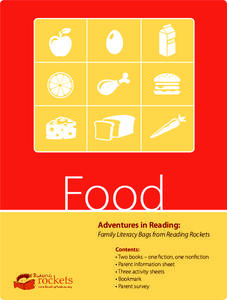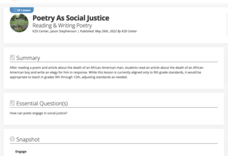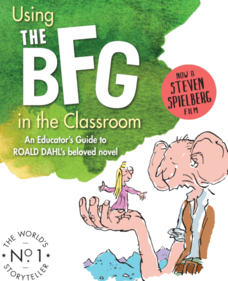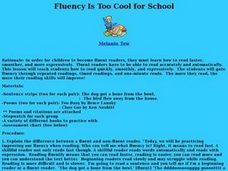Social Media Toolbox
Social Media Usage
Is there a difference in the way organizations present news via social media and in print? The third in a series of 16 lessons from The Social Media Toolbox explores news outlets and their delivery methods. Groups follow a story for a...
EngageNY
Poetic Tools in Narrative of the Life of Frederick Douglass
Scholars listen to a reading and answer probing questions about If We Must Die by Claude McKay. Readers annotate their personal copies of the poem as they discuss its figurative language, vocabulary, and meaning. They then transfer...
PBS
Reading Adventure Pack: Food
An activity packet about food begins with reading two texts: Stone Soup by Marcia Brown or John Muth and Where Does Food Come From? by Shelley Rotner and Gary Goss. Learners then take part in three activities. They design a puzzle...
PBS
Reading Adventure Pack: Government
A reading adventure pack looks closely at government with the help of two books—one fiction, one nonfiction, and a series of activities. Learners craft a mobile to visualize a balanced government, participate in a scavenger hunt around...
K20 LEARN
The Conflict at the Washita River: The Indian Wars in Indian Territory
"Battle" or "Massacre"? Words matter, especially when labeling historical events. That's the big idea in a instructional activity about the 1868 conflict at the Washita River. After examining two images of the event, groups read and...
K20 LEARN
Poetry as Social Justice: Reading and Writing Poetry
Words can be a powerful tool in the hands of a poet. Class members examine a poem written by Ross Gay in response to the death of Eric Garner and a news report of the same death. They then read an article about the death of Tamir Rice...
Digital Education Resource Archive
Narrative Writing Unit
Each one of the learners in your class has a story to tell, so help them learn the most efficient and organized way to tell their tale. A thorough unit on narrative writing addresses the writing process, grammar, story structure,...
Roald Dahl
Using The BFG in the Classroom
Use a resource that highlights Roald Dahl's seven tips for imaginative writing while reading The BFG. The activities encourage learners to become creative writers through finding harmony, establishing stamina, engaging in imaginative...
Scholastic
Getting Started with Write & Read Books
Welcome your class back to school with a mini-book. Learners fill in information about the school year and themselves and then illustrate each sentence. When they are complete, pupils can share their books and get to know their classmates.
PBS
Hidden Messages in Spirituals
Slaves laboring in the cotton fields of the old South singing joyously may have convinced overseers that their workforce was happy and content, but in truth, these spirituals contained secret codes. After viewing a short video about...
K12 Reader
Spelling Rule Exceptions for Plural Nouns: Words That End in X and Z
Pizzas is correct, not pizzaes. So why is sixes correct and not sixs? Sort out any grammar confusion with a worksheet on pluralizing nouns that end in -z or -x.
Literacy Design Collaborative
Betrayal in Literature—Barreiro
What do Roald Dahl's "Lamb to the Slaughter" and the Book of Genesis have in common? Both are complex texts that model how authors can approach the same concept—betrayal—in very different ways.
Ashoka
A Toolkit for Promoting Empathy in Schools
Instill kindness with a unit all about empathy. Lessons and activities follow a prepare, engage, reflect, and action sequence. Learning experiences include making the classroom a safe environment, peer-invented handshakes, discussions...
Greater Good Science Center
Seeing The Good In Others
Showing gratitude is an intentional act and it's the glue in relationships. That's the big idea in a lesson for tween and teens. Scholars leave post-it thank you notes on other's character strength posters that acknowledge those strengths.
Plimoth Plantation
History In A New Light: Illuminating the Archaeology of Historic Patuxet and Plymouth
Sixty-seven pages take scholars on a digital tour through the exhibit, History in a New Light: Illuminating the Archaeology of Historic Patuxet and Plymouth. Crystal clear pictures accompanied by text offer a deep understanding of the...
Benjamin Franklin Tercentenary
Reading the Work of B. Franklin, Printer
Placing Ben Franklin’s ideas about a free press next to those embodied in the First Amendment sheds light on both. Learners interpret and compare two primary sources and then examine them in the light of a contemporary survey about...
EngageNY
Determining Author’s Opinions, Reasons, and Evidence: Signs of Hope and Progress for African Americans in the 1920s (Promises to Keep, Pages 14–15)
Caption this. Readers look at the text features in Promises to Keep and pay special attention to the photographs and captions before adding to the Features of Informational Text anchor chart. Learners then answer questions about life in...
Lied Center of Kansas
The Ugly Duckling and The Tortoise and the Hare
Both The Ugly Duckling and The Tortoise and the Hare are great additions to an elementary language arts lesson. Young readers focus on the literary elements of each story, including characters and plot development, and apply...
Prestwick House
The Orphan Train
What do a girl in foster care and a 91-year-old widow have in common? A crossword puzzle related to Orphan Train highlights some of the similarities the two characters share in the book. The puzzle pulls out key details from the novel to...
Curated OER
Fluency Is Too Cool for School
What does a successful reader sound like? Help readers gain fluency and become successful readers through repeated readings of given poems. They use the cover-up method to help them decode new words and chart their progress as they...
Curated OER
Third Grade Fluency Lesson
Looking for an activity to increase fluency? Third graders will practice reading comprehension by expanding their reading level. They will demonstrate for their teacher their current reading level and then decide on a goal to be reached...
Curated OER
Reading Connected Text Fluency (Passage)
Practice makes perfect when it comes to reading fluency! Walk your emerging readers through a familiar passage, slowly pointing to each word to keep every learner with you. While looking at a projected passage, scholars read one word at...
Curated OER
Hop on the Express Train to Read Expressively
Encourage beginning readers to read expressively. After the teacher models what it's like to read with expression, pairs of learners work together to practice developing this ability. While one learner reads, the other marks a check-list...
Curated OER
Guided Reading with Jazz Baby
Jazz music and musicians are the focus of this language arts instructional activity. Young readers independently read the book Jazz Baby. To build fluency and independence they read silently, but are guided by directive comments from the...
Other popular searches
- Making Inferences in Reading
- Generalizations in Reading
- Context Clue in Reading
- Inferences in Reading
- Graphic Sources in Reading
- Fractional Parts in Reading
- Visualization in Reading
- Cloze Activity in Science
- Predictions in Reading
- Draw Conclusions in Reading
- Sequential Order in Reading
- Asking Questions in Reading

























